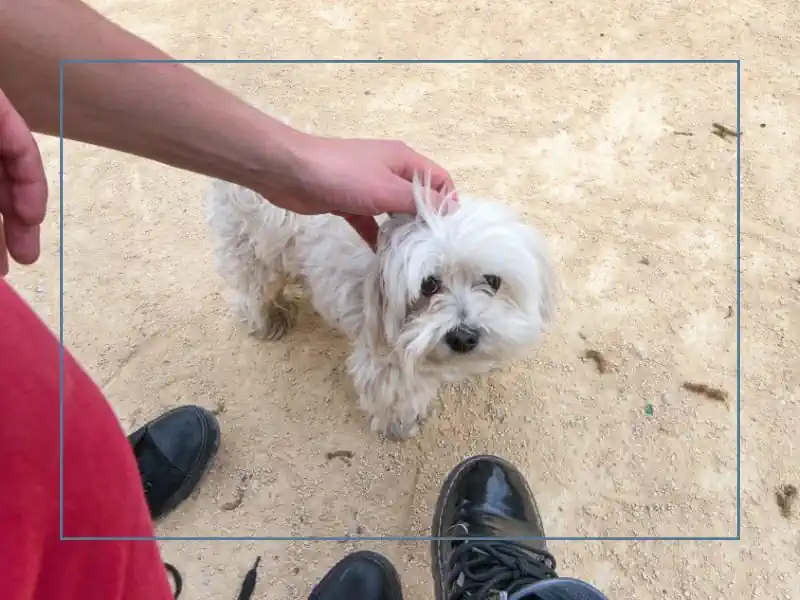- Home
- Dog Adoption
- fostering
Fostering A Dog: Your Guide on How to Become a Dog Foster Parent
WRITTEN BY STACY | EVERYTHINGSHIHTZU.COM
As a dog lover, at some point you’ve probably thought about fostering a dog in your home. What it would be like or even how to become a temporary guardian of a shelter animal.
Fostering can be extremely rewarding, but it also takes a lot of patience, dedication, and effort.

If you think you may want to take in shelter dog, or maybe you’re just curious, then check out this step-by-step guide on how to become a dog foster parent.
The first step to fostering a dog, is to contact your local rescue organizations and ask if they have a foster program.
This initial contact is an excellent time to find out the specific requirements for that rescue and see if you meet the minimum qualifications for the program. If you do qualify you will likely be asked to fill out an application.
Be sure to review the application closely, and ask any questions you have before completing the process.
If your application is accepted you will be notified of potential dogs that you can foster.
Pet overpopulation is a huge problem, but fostering a dog is one way that you can help give these animals a better life.
Shelters and rescues only have limited space so when they run out, certain pets either need to go elsewhere, or they are, sadly, euthanized.
Fostering can help save a life, but it’s important to know your limits and understand what fostering a dog entails.
Think you want to give fostering a try?
Keep reading to learn tips on finding rescues; what will be expected of you as a pet foster; and questions you should ask before taking on the commitment of fostering a dog.
Getting Started in Fostering a Dog
 Max
MaxShelter environments can be stressful places, especially for dogs that are older, very young puppies, pregnant dogs, or animals with health issues.
Unfortunately, some of these dogs also have the most trouble getting adopted, so they get stuck in the shelter, but this is where fostering a dog becomes so important.
When you are willing to open your home to these animals, you also open your heart, and incredible things can happen, but you need to know what to do first.
A good place to start is petfinder.com.
This site is a great resource for finding rescue organizations that are near you, but if you are willing to branch out from your local area, you can also search for breed-specific rescues or other organizations that hold a special meaning for you.
There are rescues, for example, that concentrate on only toy breeds, or pregnant pups, or senior dogs.
The possibilities are almost endless if you are willing to travel a bit.
Check out the different rescues that you come across and find one or two that tug at your heartstrings.
Your next step is to contact the rescue in order to request an application for fostering a dog.
When you receive the application, review it carefully, and make sure you understand everything that would be required of you as a foster.
You want to know all of the expectations upfront so you can make an informed decision about whether or not you are able to handle taking care of a shelter animal.
Have your references ready.
The rescue will most likely expect you to deliver references so they can evaluate your potential as a care giver.
If you already have pets, they will also want a reference from your vet, or may even want to speak with your veterinary clinic.
If you plan on fostering a dog, and you do not already have a pet, then it is important to get established with a veterinary office.
The rescue will most likely have recommendations of vets they already work with that they can refer you to.
Be prepared to ask a lot of questions.
After you take in a foster is not the time to start asking questions about the dog or the fostering process.
Before you agree to the big commitment of fostering a dog, ask the rescue all of your questions.
You’ll most likely have an interview with the rescue as part of the application process, so this is a great time to get answers.
Here are some questions that you should include on your list:
- Does this dog require specific medical attention?
- Will you be required to give the pup any medications?
- Who pays for the vet bills?
- Does the dog have a microchip? If not, are you expected to get the dog chipped?
- Who pays for the necessary items like food, medicine, leash and collar, grooming needs, and other supplies?
- Are you expected to have a fenced-in yard for the dog?
- Will you be expected to train the pup? If so, to what extent?
- Where do you bring them for adoption events? How many are you expected to attend?
- Does the rescue hold meetings that you are expected to attend?
- Are you expected to bring the dog to meet potential adopters? If so, are you able to set the schedule?
- Is the dog good with other animals and children?
- How is the dog with strangers?
- What is the animals history? For example, does he come from an abusive environment, is he a stray, or was he in a loving home that for whatever reason could no longer keep him?
- Will you need to be home with the pup all day?
- Where is the dog currently on his shot schedule? You will need to know his medical/vet history so that you can keep up with the appropriate timeline of vaccinations and well visits.
In addition to the questions that you ask the rescue, there are other questions that you need to have answers to.
These are the questions that you have to ask yourself, and in some cases, your local governing agency and homeowner’s insurance.
You will want to find out if your city has any breed restrictions in place where you live, and you will want to find out the same from your homeowner’s insurance.
Certain insurance companies, for example, will not cover you or will require extra coverage, for certain breeds and dogs like pit bulls or German Shepherds.
If you live in an apartment or condo complex, you will want to find out what the restrictions are for pets such as if you can even have one, what are the weight restrictions, and the number of dogs allowed.
Then ask yourself these questions.
- Are you willing and able to put in the time required to foster this particular animal?
- Can you handle a dog that needs someone with him all day?
- If you have stairs in your home, can the dog handle going up and down the stairs?
- If you have other pets or children, are you willing to take the extra steps necessary to acquaint them all together?
- What are you prepared to deal with when it comes to specific issues like separation anxiety, excessive barking, jumping on people, socialization issues, and so forth.
If you don’t have the necessary knowledge to deal with these problems, are you willing to consult with and work with a trainer? - Are you willing to deal with health problems like incontinence, allergies, or more serious health conditions that require a lot of extra attention? Are you willing to administer medications?
- Are you willing to take in a dog with mobility issues like using a wheelchair, missing a leg, or a dog that is deaf or blind?
- Are you willing to groom the animal as needed, or pay for grooming services if necessary?
- Are you willing to completely change your living situation to care for these animals?
Once you have the answers to all of these questions, you can make an educated and informed decision about whether fostering a dog is for you.
If it is, then you can finalize the application process and bring home your foster pup.
You will usually get to choose which dogs you are able to foster out of those that are eligible.
For example, if you have small children at home you can choose a dog that is known to be good with kids.
If you know you will not be home all day long, you most likely will not choose a young puppy or a dog that has serious health issues that need to be monitored twenty-four-seven.
So let’s recap. If you want to become a foster parent for dogs, then, in a nutshell, the steps to follow are:
- Find a rescue to work with that interests you.
- Fill out an application to foster.
- Read the application carefully.
- Provide references to the rescue.
- Ask a lot of questions.
- Finalize the application process.
- See dogs that are eligible to foster.
- Bring home your foster.
What Are Your Responsibilities When Fostering a Dog?
When you agree to fostering a dog, you take on a considerable amount of responsibility.
After all, you’re in charge of another living thing’s life and future, and that’s a big deal.
As a foster, your main responsibility is to ensure that the animal receives all necessary age-appropriate shots, attends any and all veterinary well-checks and visits, and receives any special medical attention for any health issue the pet may possess.
You also need to make sure that your foster pet is properly fed, and of course, give him lots of love.
It is critical to remember that a big role that foster pet parents play is prepping the dogs in their care for adoption.
This means you need to work with the pup on socialization, behavior and training, the extent of which will depend on the individual dog.
Once a pet in your care is considered to be ready for adoption, it is also your responsibility to do everything you can to help find a forever home for your canine charge.
This can consist of attending adoption events with the animal and performing house checks and interviews of potential adopters.
Those are the logistical things that you are expected to take care of when fostering a dog, but there are also unseen things that you are responsible for, for example, only taking in a dog if you know you will fully be able to care for it.
It is your responsibility to make smart decisions and to know when to say yes, and when to say no.
It does a dog no good to be fostered by someone who really doesn’t have the time or patience to care for him.
This can ultimately make him take steps backward in his path to becoming an adoptable pet.
These dogs need proper attention and love, some more than others, in order for them to get where they need to be if they want to be adopted.
Preparing Your Home for Fostering Dogs?
Anytime you bring a new pet into the house, you can expect big changes.
Whether you are adopting a pet of your own or taking in a foster dog, you will need to make certain preparations to make the transition easier for all those involved, both man and animal.
First things first, make sure that you have discussed fostering with anyone who is also living in your household, including children.
Remember, this is a big change, and things will be different, so everyone at least needs to be on board with the idea, and hopefully, everyone will agree to chip in and take care of the dog, too.
For example, perhaps one child can be in charge of making sure the dog always has fresh water in his bowl, while someone else may be in charge of the evening walk.
Next, you want to make sure your house is ready inside an outside so do a quick assessment.
If there are certain rooms the dog will not be allowed in, then do you need to install pet gates?
If you have stairs and do not want the dog to go upstairs, then you might want to put a gate across the bottom of your stairway.
If you don’t have a fenced-in backyard, you may want to consider putting up a fence, especially if you plan on fostering dogs on a continuing basis.
This is especially handy if you have dogs that need to be let out at night to potty, or at times when you are unable to take them for a walk, say when it’s raining.
Instead, they can do a quick potty stop and take a few laps around the backyard.
You will also want to set up a designated spot for your temporary housemate.
You might get a special dog bed in the corner of the living room, or maybe even designated areas in multiple rooms that can be the dog’s safe place.
A crate works well for this too, as many dogs will associate it with their den.
However, it works best if you can leave the door to the crate open so the pet can come and go, and not feel trapped or punished.
Take some time to gather all the necessary supplies and organize them ahead of time.
You don’t want to be scrambling for things that you need once the dog is already in your house.
Plus, you’ll have more time to devote to your new furry friend and acclimating him to his new, temporary home.
Also, make sure to work out the new schedule with anyone involved before Rover arrives.
This will help make the transition go more smoothly for everyone, including your new pup guest.
If you already have a pet, there are extra precautions that you may want to consider taking when fostering dogs.
Your foster could potentially bring some communicable diseases into your home from the shelter.
You may want to consider setting up a temporary quarantine of sorts for your foster dog in order to keep your pets safe.
Your vet is a good person to talk with about this idea.
If you want, when you get your foster, make it a point to have an appointment pre-scheduled with your vet so that you can introduce your foster and have him checked out, that way your vet can give you a more informed recommendation of what should be done, if anything.
If after reading this, you feel like fostering a dog is something you strongly desire to do, then a great starting point is to get in touch with your local rescues.
These organizations can help you get on the right path and help guide you through the process.
Just make sure that you are ready for the commitment that fostering entails.
To learn more about dog fostering, adoption, and all things Shih Tzu, make sure to check out the rest of our blog!
We wish you and your furry companions the very best!
Rescues Looking For Volunteers
- Home
- Dog Adoption
- fostering



